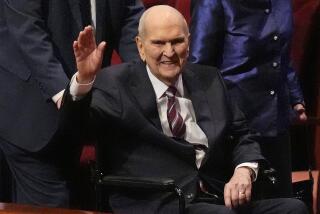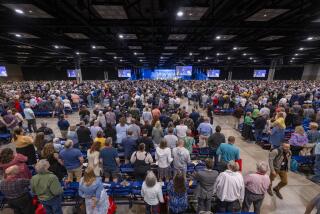Mormons May Disavow Old View on Blacks
- Share via
Twenty years after the Mormon church dropped its ban against African Americans in the priesthood, key leaders are debating a proposal to repudiate historic church doctrines that were used to bolster claims of black inferiority.
The proposal to disavow the teachings, which purport to link African American skin color to curses from God recounted in Hebrew and Mormon Scriptures, is under review by the church’s Committee on Public Affairs, made up of members of the church’s highest governing circles, known as general authorities.
Sources close to the sensitive and still secret deliberations hope that a statement will be issued as early as next month, the 20th anniversary of the landmark 1978 decision by the Church of Jesus Christ of Latter-day Saints to admit all worthy men to the priesthood, regardless of their race or color.
Although the church’s leaders now proclaim racial equality as a “fundamental teaching,” the process of repudiating old doctrines remains difficult. Those involved in the internal discussions say church leaders are searching for a formula that will allow them to retract earlier statements without undermining the faith of believers or the credibility of previous church figures whom the Mormons revere as prophets whose pronouncements were inspired by God.
“They feel like a lot of people may not believe the church is true because a lot of these things were said by previous prophets, and a true prophet of God shouldn’t make mistakes,” said David Jackson, an African American Mormon who is among those calling for change.
Continued Growth in Africa
The call for change comes at a time when the 10-million-member church is enjoying unprecedented growth in Africa and other developing countries. Several months ago the church’s president and prophet, Gordon B. Hinckley, wrapped up a five-nation tour of Africa, where the church reports about 110,000 converts as of the end of 1997, the latest figures available.
But black members of the church in the United States as well as some Mormon scholars warn that the “racist legacy” contained in various Mormon documents and authoritative statements risks undermining its mission unless they are disavowed.
“In the absence of any official corrections, these speculative and pejorative ideas will continue to be perpetuated in the church indefinitely,” Mormon scholar Armand L. Mauss wrote in one internal paper prepared for church officials. Mauss is president of the Mormon History Assn. and a professor of sociology and religious studies at Washington State University in Pullman, Wash.
For most white members, the place of blacks in the church was resolved once and for all by the church’s landmark 1978 decision on the priesthood.
For many blacks, however, the decision did not go far enough.
“What [the 1978 revelation] doesn’t say is we’re no longer of the lineage of Cain, that we no longer did these things in preexistence. It does not say we are not cursed with black skin,” Jackson said.
Irvine attorney Dennis Gladwell, who has been working with Mauss and Jackson, made a similar point in a paper presented in October 1996 to Elder Marlin K. Jensen, a high-ranking official of the church and a public affairs committee member.
“It is the linkage to Cain that so distresses Mormon African Americans today,” Gladwell wrote. “It places their spiritual lineage in shambles, since they are alleged descendants of a man who has come to symbolize evil on the same level as Lucifer himself.”
Although church officials would not comment directly on what the First Presidency, composed of Hinckley and his two counselors, or the Quorum of the Twelve Apostles, may have considered, they confirmed that discussion of the issue is moving forward. The First Presidency and the Twelve Apostles are the principal policymaking and administrative officers of the church. The Quorum of the Seventy, of which Jensen is a member, ranks just below and carries out their policies.
“There appears to be general enthusiasm for moving ahead to clarify anything that would have previously hurt African Americans,” one source close to developments in the public affairs committee said.
William S. Evans, a public affairs committee staffer, confirmed that the committee members have discussed the matter. But he cautioned that only the church’s highest authorities--not the committee--could make such a statement.
An opening for the church could come as early as next week when Mauss delivers what is described as a major paper on the subject in Washington, D.C.
Among those who have read the paper is Jan Shipps, professor emeritus of history and religious studies at Indiana University-Purdue University at Indianapolis. She said the paper makes the point that the church’s racist legacy developed only after the death of its founder and prophet, Joseph Smith.
“So the church itself could pull back from it as a matter of reinterpretation without having to lay itself open to the charge of changing doctrine,” Shipps said.
Mormon Theology, Hebrew Scripture
In the past, Mormons as well as other churches believed that Africans were descendants of the biblical personages Cain and Ham, who, according to the Bible, displeased God and were cursed.
Hebrew Scripture says that Cain was the son of Adam and Eve and killed his brother, Abel. Ham was the second son of Noah, who built the Ark before the great flood recounted in the Bible. Ham broke a taboo by looking at his father’s nude body after Noah passed out from drinking too much wine.
Ham is also known in the Bible as the father of Canaan, whom Noah, after awaking from his stupor, condemned to servitude.
Over time, the curses on Ham and Cain came to be associated with black skin and were used as a justification for slavery--and, in the case of the Mormon church, one rationale for denying its priesthood to blacks.
Mormon theology has added another explanation: Blacks on Earth were among those spirit children of God in what Mormon theology refers to as “preexistence”--the time before God’s spirit children took human form on Earth--who failed to fight valiantly enough for God during a heavenly war with the devil. Nonetheless, they were permitted to take on human form--along with the spirit children who did fight valiantly for God--but had to take on black bodies.
For that reason, the 1978 revelation admitting blacks to the priesthood shocked the Mormon world, and was widely celebrated as a new time and a new dispensation bringing blacks into full fellowship.
Typical of the remarks at the time were those of the late Apostle Bruce R. McConkie, who earlier had been a staunch defender of keeping blacks out of the priesthood as the will of God.
“Forget everything that I have said, or what President Brigham Young or President George Q. Cannon or whosoever has said in days past that is contrary to the present revelation,” McConkie said. “We spoke with a limited understanding and without the light and knowledge that now has come into the world.”
Despite such pronouncements, Mauss notes, pre-1978 statements continue to be circulated in conversations and classes at the grass-roots level as well as reprinted in current authoritative books published by the church.
Mauss warned that as these doctrines come to light there will be confusion and pain among blacks both in and out of the church.
Some black members are likely to dismiss the former statements as quaint notions from the past and continue in the church, he wrote. “Many other black members, however, find these doctrines not only unnecessary and obsolete, but demeaning and particularly difficult to explain to their children, who sometimes even encounter them during discussions in seminary classes,” Mauss wrote.
“Investigators and potential investigators learning of these doctrines are put off by them. Black converts are sometimes ridiculed by their friends and family members for joining a church in which such doctrines still circulate. These doctrines, therefore, retain a potential for undermining the mission of the church as it strives to strengthen the saints and proclaim the Gospel. They also constitute a potentially serious public relations problem, and an entirely unnecessary one,” he wrote.
The early historical Mormon record is uneven, punctuated by contradictory statements and actions. For example, scholars note that a black man, Elijah Abel, was given the priesthood in the 1840s, and that church’s highest authority, the First Presidency, wrote in 1840 that “persons of all languages, and of every tongue, and of every color” would worship in the temple.
But there is general agreement that after Smith’s death, the church’s views and practice changed under Brigham Young.
As late as 1949, the church’s First Presidency, the highest ruling authority that includes the president and prophet and his two counselors, officially reaffirmed the ban on blacks in the priesthood by quoting Young as saying that those who were “cursed with a skin of blackness” were so marked because their fathers rejected the power of the holy priesthood and the law of God.
The 1949 statement also reaffirmed the theological assertion that those spirits in the preexistence who did not valiantly fight for God took on black bodies when they came to Earth.
Jackson and Gladwell, who describe themselves as devoted to the church, said they take heart in what they see as the church’s forward movement. Now, they said, the time has come to take the next step.
“The doctrinal framework once used to justify the earlier priesthood restriction is still with us,” Mauss wrote in a paper presented last July to Jensen. “Presumably little can be done about ideas from the past that continue to appear in books that are published and republished. Much can be done, however, to neutralize the continuing spread of these doctrines through explicit initiatives on the part of the First Presidency and/or the Quorum of the Twelve.”
More to Read
Sign up for Essential California
The most important California stories and recommendations in your inbox every morning.
You may occasionally receive promotional content from the Los Angeles Times.










